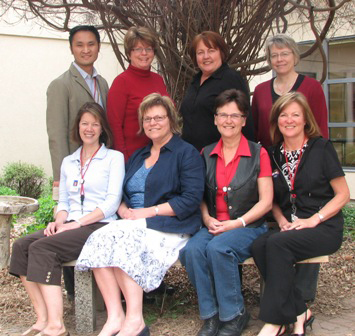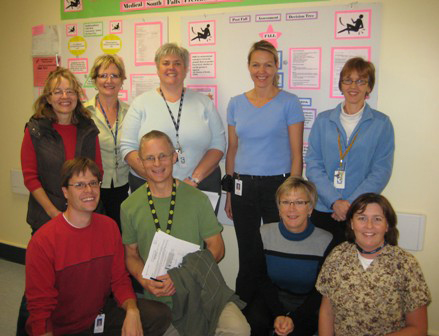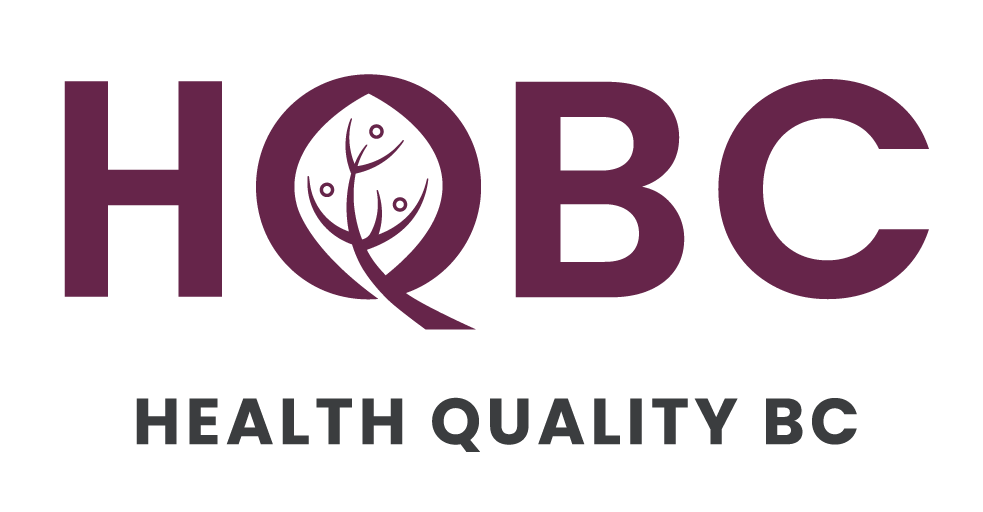Awards were given to two sites in Interior Health, both showing significant results related to falls prevention. Falls prevention teams at Brookhaven Care Centre and Penticton Regional Hospital have both developed creative strategies to reduce the number of falls, the number and severity of fall-related injuries and the use of restraints in their facilities.
Brookhaven Care Centre Falls Prevention Team

Brookhaven Care Centre is located in West Kelowna and has 104 beds. In 2008, Brookhaven was the only site within Interior Health to participate in the Safer Healthcare Now! national collaborative on falls in long-term care. This collaborative concluded in May 2009, but the work of the Brookhaven team continues. From May 2008 to May 2009, the team was able to significantly reduce the number of injuries from falls in their facility and reduce the use of restraints by 53 per cent without an increase in falls. Their work has been accomplished through dedication to a client-centred approach that prioritizes quality of life and personal independence while addressing the risk of falls on an individual basis.
While participating in the collaborative, the Brookhaven falls prevention team implemented a variety of creative strategies in the following areas:
- Staff engagement and education: All staff, including nursing, rehabilitation, housekeeping and maintenance, received education on fall and injury prevention through education and an interactive “fall risk room” where staff were encouraged to identify fall risks. Visual reminders, such as pictures over beds to indicate which protective gear individuals should be using, were developed to prompt staff to think about the risk of falls when providing care.
- Family and individual education: Two brochures for educating family members on hip protectors and fall prevention and restraints were developed.
- Reduction of use of mechanical restraints: One full bed rail was removed from 80 per cent of beds; 12 per cent of lap belts were removed; and all other mechanical restraints, including wheelchair belts, thigh belts and T-straps, were removed.
- Fall and injury prevention: Hi-low beds and fall mats were made available for people who were identified as high risk and a number of individualized strategies, such as non-skid socks, vitamin D and calcium supplements, and hip protectors, were implemented to reduce the risk of injuries.
- Documentation and reporting: A fall risk screening tool is now used during the admission process, and after any fall or change in an individual’s health or status.
The success of the Brookhaven team is now being shared throughout Interior Health. The Residential Fall Prevention Community of Practice meets monthly via teleconference to share information and provide direction for regional strategies in fall prevention. The Brookhaven brochures and educational materials are being adapted across the continuum of care throughout Interior Health. Regional standards and recommendations for the use of fall mats are being developed and the fall risk screening tool is currently being implemented as the first regional fall prevention strategy. Members of the Brookhaven team will also be advising on the development of clinical practice standards to support the new Interior Health Policy of Least Restraint and new Clinical Practice Standards for Fall Prevention.
Penticton Regional Hospital Falls Prevention Team

Bottom Row (from left to right): Rob Giachino, Harald Simmerling, Shelley Smillie, Marcey Kindel.
Missing from Photograph: Irene Goodis.
The Penticton Regional Hospital (PRH) has succeeded in developing a comprehensive, multi-disciplinary fall prevention program that serves as a model for other hospitals in Interior Health. There were 43 per cent less falls and a 57 per cent reduction in the number of people identified as having a high risk of falling during the initial pilot program.
In August 2007, the PRH falls prevention team was formed as a grassroots initiative to address the issue of the number of patient falls occurring in their hospital. The purpose of the team was to develop and implement best multi-disciplinary practice guidelines to improve the identification of patients at risk for falls, implement interventions to reduce the number of falls and injury, and improve the care that is provided after a fall occurs.
Within the first year, the PRH falls prevention team conducted a literature review and one of the members completed the Canadian Fall Prevention Curriculum course. Based upon their research and training, they developed the following tools and protocols:
Falls risk screening tool: Five questions were incorporated into the nursing history/admission form to identify patients who were at high-risk of falling. These questions focused on: history of falls; altered mental state; impaired mobility, balance or gait; five or more medications; and alterations of bladder/bowel and/or frequent toilet use.
Multi-disciplinary falls risk action/care plan and decision tree: Tools include sections for nursing, rehabilitation, pharmacy, nutrition and social work.
Post-fall assessment/documentation record and decision tree: Focused on clinical evaluation of patients following a fall using the Glasgow Coma Scale (eye, verbal and motor responses).
Environmental assessment audit tool: A scan of potential risks in the hospital including: lighting, clutter, pathways, handrails, bathrooms, bedrooms, and devices to help patients.
“Five easy questions”: Nurses were directed to ask five questions before they leave the patient rooms:
- Do you have any pain or discomfort?
- Do you need to use the toilet?
- Is there anything more I can do for you?
- Is your call bell within reach?
- Is your table within reach?
Falls prevention program pamphlet: Educating patients and families.
Over-bed universal falls precautions signage: The PRH team expanded on a Fraser Health poster to include patient-specific fall prevention interventions.
Identifiers for “at risk” patients: Patients at risk are easily identifiable with hot pink armbands and dots on the patient’s chart and care plan.
Rest stop chairs for hallways: Chairs were purchased and covered in hot pink vinyl to stand out and raise awareness of patient falls.
Staff surveys: Conducted to determine the effectiveness of education sessions.
In the past year, the PRH falls prevention team has continued to focus on improving their program by adding new elements such as a physician notification sheet to let physicians know that their patient has been identified as a high risk for falls, what referrals have been made, and to request an order for vitamin D. They have spread their program to other units, including the Rehabilitation Unit and the General Surgery and Orthopaedics Unit. They continue to focus on the sustainability of their program, and to embed falls prevention into everyday practice, such as by having unit clerks prepare a “fall prevention package” for each new admission. They conduct regular audits to assess staff compliance and make changes as needed.
The PRH team is sharing their program successes and challenges throughout Interior Health via the Acute Care Fall Prevention Community of Practice (CoP). The CoP meets monthly via teleconference to share information and provide direction for regional strategies in fall prevention. Vernon Jubilee Hospital has recently adopted PRH’s five screening questions and universal falls precautions posters for a pilot fall prevention project. Regionally, Interior Health is in the process of implementing its first ever regional strategies for fall prevention in acute care, including the Universal Fall Precautions poster (adapted from the PRH and Fraser Health posters) and the Three Easy Questions poster.
For more information, please contact Kelly Wilson (Patient Safety Coordinator, Fall Prevention, Interior Health) at kelly.wilson@interiorhealth.com.

